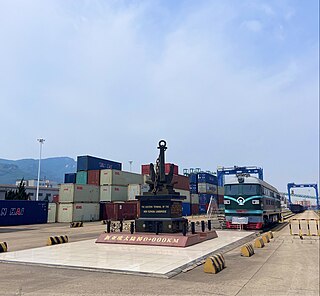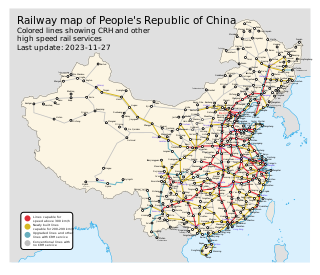Transport in Turkmenistan includes roadways, railways, airways, seaways, and waterways, as well as oil-, gas-, and water pipelines. Road-, rail-, and waterway transport fall under the jurisdiction of the Ministry of Industry and Communications.

Containerization is a system of intermodal freight transport using intermodal containers. The containers have standardized dimensions. They can be loaded and unloaded, stacked, transported efficiently over long distances, and transferred from one mode of transport to another—container ships, rail transport flatcars, and semi-trailer trucks—without being opened. The handling system is completely mechanized so that all handling is done with cranes and special forklift trucks. All containers are numbered and tracked using computerized systems.

Narvik (help·info) is the third-largest municipality in Nordland county, Norway, by population. The administrative centre of the municipality is the town of Narvik. Some of the notable villages in the municipality include Ankenesstranda, Ballangen, Beisfjord, Bjerkvik, Bjørnfjell, Elvegård, Kjøpsvik, Skjomen, Håkvik, Hergot, Straumsnes, and Vidrek. The Elvegårdsmoen army camp is located near Bjerkvik.

The Norwegian railway system comprises 4,087 km of 1,435 mm track of which 2,622 km is electrified and 242 km double track. There are 696 tunnels and 2,760 bridges.

Intermodal freight transport involves the transportation of freight in an intermodal container or vehicle, using multiple modes of transportation, without any handling of the freight itself when changing modes. The method reduces cargo handling, and so improves security, reduces damage and loss, and allows freight to be transported faster. Reduced costs over road trucking is the key benefit for inter-continental use. This may be offset by reduced timings for road transport over shorter distances.
The Trans-Asian Railway (TAR) is a project to create an integrated freight railway network across Europe and Asia. The TAR is a project of the United Nations Economic and Social Commission for Asia and the Pacific (UNESCAP).

The Eurasian Land Bridge, sometimes called the New Silk Road, is the rail transport route for moving freight and passengers overland between Pacific seaports in the Russian Far East and China and seaports in Europe. The route, a transcontinental railroad and rail land bridge, currently comprises the Trans-Siberian Railway, which runs through Russia and is sometimes called the Northern East-West Corridor, and the New Eurasian Land Bridge or Second Eurasian Continental Bridge, running through China and Kazakhstan. As of November 2007, about one percent of the $600 billion in goods shipped from Asia to Europe each year were delivered by inland transport routes.

The Port of Felixstowe, in Felixstowe, Suffolk, is the United Kingdom's busiest container port, dealing with 48% of Britain's containerised trade. In 2017, it was ranked as 43rd busiest container port in the world and 8th in Europe, with a handled traffic of 3.85 million twenty-foot equivalent units (TEU).

Rail freight transport is the use of railroads and trains to transport cargo as opposed to human passengers.

Rail transport in Sweden uses a network of 15006.25 km of track, the 22nd largest in the world. Construction of the first railway line in Sweden began in 1855. The major operator of passenger trains has traditionally been the state-owned SJ AB, though today around 70% of all rail traffic consists of subsidised local and regional trains for which the regional public transport authorities bear responsibility. Passenger traffic has increased significantly since the turn of the millenium, and in 2019 Sweden ranked number five in the world and number three in the European union, as well as number sixth in the world when measured by passenger share.

The Ofoten Line is a 43-kilometre (27 mi) railway line in Narvik, Norway. It runs from the Port of Narvik to Riksgränsen on the Norway–Sweden border, where the line continues as the Ore Line via Kiruna and Gällivare to Luleå. The Ofoten Line is single track, electrified at 15 kV 16.7 Hz AC and has seven stations. The line only connects to the rest of the Norwegian railway network via Sweden. The main traffic is up to 12 daily freight trains operated by Malmtrafik that haul iron ore from Sweden to Narvik. In addition, CargoNet operates container trains, branded as the Arctic Rail Express (ARE), and SJ operates passenger trains, including a night train to Stockholm.

The Meråker Line is a 72-kilometer (45 mi) railway line which runs through the district and valley of Stjørdalen in Trøndelag county, Norway. The line branches off from the Nordland Line at Hell Station and runs eastwards to the Norway–Sweden border, with Storlien Station acting as the border station. From there, the line continues as the Central Line. Traditionally, the Meråker Line was regarded as the whole line from Trondheim Central Station to the border, a distance of 102 kilometers (63 mi). There are two daily passenger train services operated by the Norwegian State Railways and a limited number of freight trains hauling lumber and wood chippings.

The Islamic Republic of Iran Railways is the national state-owned railway system of Iran. The Raja Passenger Train Company is an associate of the IR, and manages its passenger trains. The Railway Transportation Company is an associate of the IR, which manages its freight transport. The Ministry of Roads & Urban Development is the state agency that oversees the IRIR. Some 33 million tonnes of goods and 29 million passengers are transported annually by the rail transportation network, accounting for 9 percent and 11 percent of all transportation in Iran, respectively (2011).

The Iron Ore Line is a 398-kilometre (247 mi) long railway line between Riksgränsen and Boden in Norrbotten County, Sweden, owned by Trafikverket. The line also contains two branches, from Kiruna to Svappavaara and from Gällivare to Koskullskulle. The term is often colloquially used to also include the Ofoten Line, from Riksgränsen to Narvik in Norway, and the northernmost part of the Main Line Through Upper Norrland from Boden to Luleå. The railway from Narvik to Luleå is 473 kilometres (294 mi) long.

A well car, also known as a double-stack car or stack car, is a type of railroad car specially designed to carry intermodal containers used in intermodal freight transport. The "well" is a depressed section which sits close to the rails between the wheel trucks of the car, allowing a container to be carried lower than on a traditional flatcar. This makes it possible to carry a stack of two containers per unit on railway lines wherever the structure gauge assures sufficient clearance. The top container is secured to the bottom container either by a bulkhead built into the car, or through the use of inter-box connectors (IBC). Four IBCs are needed per wellcar. In the process of an inbound train becoming an outbound train, there are four processes: unlock to unload the top container of inbound train, remove then unload bottom container, insert after loading bottom container of outbound train, lock after top container loaded.
FESCO Transportation Group is the largest intermodal transport operator in Russia, which provides services, including marine shipping, Roll-on/roll-off, rail transportation and port handling via more than 70 sales offices located around the world. The parent company of the Group is Far-Eastern Shipping Company JSC. FESCO Group is headquartered in Moscow.

The New Eurasian Land Bridge, also called the Second or New Eurasian Continental Bridge, is the southern counterpart to the Eurasian Land Bridge and runs through China and Central Asia with possible plans for expansion into South and West Asia. The Eurasian Land Bridge system is important as an overland rail link between China and Europe, with transit between the two via Central Asia and Russia.

The International North–South Transport Corridor (INSTC) is a 7,200-km-long multi-mode network of ship, rail, and road route for moving freight between India, Iran, Afghanistan, Azerbaijan, Russia, Central Asia and Europe. The route primarily involves moving freight from India, Iran, Azerbaijan and Russia via ship, rail and road. The objective of the corridor is to increase trade connectivity between major cities such as Mumbai, Moscow, Tehran, Baku, Bandar Abbas, Astrakhan, Bandar Anzali, etc. Dry runs of two routes were conducted in 2014, the first was Mumbai to Baku via Bandar Abbas and the second was Mumbai to Astrakhan via Bandar Abbas, Tehran and Bandar Anzali. The objective of the study was to identify and address key bottlenecks. The results showed transport costs were reduced by "$2,500 per 15 tons of cargo". Other routes under consideration include via Kazakhstan and Turkmenistan.

Rail transport is an important mode of long-distance transportation in China. As of 2020, the country had more than 146,000 km (90,720 mi) of railways, the second longest network in the world. By the end of 2020, China had just under 38,000 kilometres of high-speed rail (HSR), the longest HSR network in the world.
The Yiwu – London Railway Line is a freight railway route from Yiwu, China, to London, United Kingdom, covering a distance of roughly 12,000 km. This makes it the second longest railway freight route in the world after the Yiwu-Madrid railway line, which spans 12,874 km. It is one of several long-distance freight railway routes from China to Europe on the "New Eurasian Land Bridge" and part of establishing a modern-day Silk Road. The route was opened on 1 January 2017, making London the 15th European city to have a railway route connection with China, and takes 18 days to complete.
















